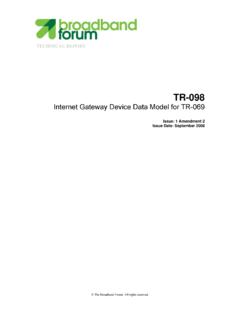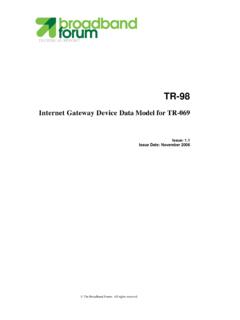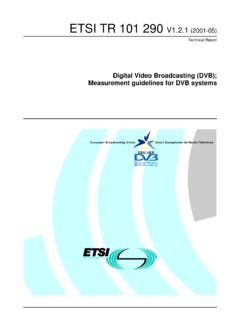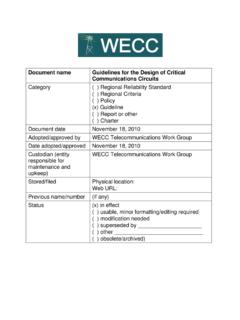Transcription of MPLS in LTE - Broadband Forum
1 MARKETING REPORT The Broadband Forum . All rights White Paper on Use of mpls in LTEI ssue: 1 Issue Date: February 2010 MMBI White Paper on Use of mpls in LTEMR-238 Issue 1 February 2010 The Broadband Forum . All rights reserved2 of 23 Issue HistoryIssue umberIssue DateIssue EditorChanges1 February 2010 Bhaskara ChinniOriginalComments or questions about this Broadband Forum Marketing Report should be directed MMBI White Paper on Use of mpls in LTEMR-238 Issue 1 February 2010 The Broadband Forum . All rights reserved3 of 23 Editor:Bhaskara CommitteeChairYue ChenJuniper ChairRao CherukuriJuniper ShahJuniper Le ClechFrance NacamuraNokia Siemens SprecherNokia Siemens White Paper on Use of mpls in LTEMR-238 Issue 1 February 2010 The Broadband Forum . All rights reserved4 of 23 Contents1 EXECUTIVE SUMMARY.
2 52 MARKET TRENDS AND CHALLENGES .. 63 THE mpls IN MOBILE BACKHAUL INITIATIVE .. FROM 2G/3G TO LTE .. 2/LAYER 3 VPN .. are the security issues?.. are the security options? .. QUALITY Engineering and QoS .. IN THE MOBILE BACKHAUL in Mobile Backhaul Standardization with Next-Generation Broadband Network .. 204 FUTURE .. 215 CONCLUSION .. 22 MMBI White Paper on Use of mpls in LTEMR-238 Issue 1 February 2010 The Broadband Forum . All rights reserved5 of 231 Executive SummaryMobile backhaul is a crucial part of the mobile network that links the Radio Access Network(RAN) and the mobile core network. Typically it consists of access and aggregation portions of a mobile network. Mobile backhaul traffic is expected to explode with the growing consumer interest in smartphones, dongles, and netbooks that demand high data bandwidth.
3 Increasing numbers of mobile subscribers, irrespective of economic conditions, is another major contributing providers, driven by growing bandwidth demand and marginal overall growth in average revenue per user (ARPU), are quickly moving to next-generation mobile technologies such asLong Term Evolution (LTE) and increasingly adopting Ethernet services to implement mobile backhauling. LTE offers a significant drop in cost of bandwidth, improves service provisioning, enables flexible use of frequency bands, and simplifies the network architecture. Ethernet in the backhaul delivers increased capacity per connection at a lower cost per bit thereby offering total-cost-of-ownership benefits to the service supports an all-IP RAN architecture, and IP technology with Multiprotocol Label Switching ( mpls ) can offer Ethernet services for mobile backhaul with the same quality of service (QoS) characteristics as traditional SONET/SDH or ATM/TDM technologies.
4 Many service provider deployments use mpls to ensure connection availability between two endpoints with QoS guaranteed by a service-level agreement (SLA). Furthermore, a majority of the mobile backhaul networks will be multiprotocol dominated at least for the next five to ten years. mpls is a mature technology that unifies various types of backhaul traffic and offers several migration choices to service providers, enabling them to follow the course that best suits their needs and operating Broadband Forum , through its mpls in Mobile Backhaul Initiative (MMBI), aims to define reference architectures and technical specifications for mobile backhaul deployments in collaboration with vendors and service providers. The initiative motivates vendors to offer products and services on a commonly agreed framework and enables service providers to offer new services with reduced risk and improved time to paper targets vendors and service providers that are in various stages of planning for mobile backhaul for White Paper on Use of mpls in LTEMR-238 Issue 1 February 2010 The Broadband Forum .
5 All rights reserved6 of 232 Market Trends and ChallengesIncreasing consumer interest in smartphones and cellular data modems is the primary driving factor behind the penetration of mobile Broadband . According to an ABI Research report(source: Mobile Data Traffic Analysis , ABI Research, 3Q 2009), Global mobile data traffic surpassed exabytes (EB) sent and received during 2008. By 2014, an average of EB of mobile data will be sent and received each month. The global market for LTE handsets is expected to grow from 50,000 units (2010) to 82 million by 2014. Similar growth is expected in other LTE consumer segments such as netbooks (source: ABI report on LTE 2Q 2009).Responding to increasing demand for bandwidth, service providers are quickly adopting LTE in the RAN.
6 With LTE, operators will have a powerful platform to deliver ubiquitous mobile Broadband services, with a much improved business proposition compared to older technologies. LTE offers high data rates at a reduced price per bit, better spectrum efficiency, and reduced expected throughput in the range of 100 Mbps and latency lower than 10 ms, LTE will provide a rich user experience comparable to what users have at home today with xDSL and cable connections, and with mobility being an added advantage. LTE will enable new business models around new services such as real-time online gaming, high-definition video streaming, video blogging, and peer-to-peer file exchange. Figure 1 Mobile Data Traffic GrowthMobile data traffic (see Figure 1) has recently surpassed voice traffic, and data traffic is growing exponentially while voice traffic is declining.
7 Mobile data presents an exciting opportunity for Source: Mobile Data Traffic Analysis , ABI Research, 3Q 2009 MMBI White Paper on Use of mpls in LTEMR-238 Issue 1 February 2010 The Broadband Forum . All rights reserved7 of 23operators, but the cost of providing this service is significant. This is a prime reason why mobile data is still relatively expensive compared to fixed-line Broadband . Operational expenses for most of the older backhaul technologies go up linearly with traffic, but the ARPU a service provider can get is slow growing at best. These market trends are forcing service providers to Ethernet-based packet backhaul. Ethernet interfaces offer high data capacity at a much lower cost per bit as shown in Figure 2 Mobile Backhaul Service Charges per ConnectionService providers require that the quality of their voice services are assured during the transition to packet-based backhaul, and hence a majority of current packet backhaul deployments use a hybrid approach where voice traffic is carried over TDM and data over packet.
8 The hybrid approach is expected to dominate packet backhaul deployments for many years to come as it also enables service providers to make the most out of their existing infrastructure. mpls pseudowires provide the ability to aggregate TDM voice and packet data over a common network infrastructure. They are widely deployed in the aggregation parts of mobile backhaul networks as a traffic unifying technology for various RAN types. Pseudowire technology is expected to grow quickly through 2013, as shown in Figure : Mobile Backhaul Equipment and Services, Infonetics, July 16th 2009 MMBI White Paper on Use of mpls in LTEMR-238 Issue 1 February 2010 The Broadband Forum . All rights reserved8 of 23 Figure 3 IP and Pseudowire ConnectionsMobile backhaul is increasingly becoming a strategic investment for service providers (source: World Mobile Backhaul Infrastructure Market , Frost & Sullivan, February 2009) and hence the need for flexibility is ever growing.
9 It is crucial for mobile operators to consider high speed packet access evolution and LTE requirements together in the near term, to optimize backhaul investment and potentially avoid additional expensive upgrades in the medium-to-long term. mpls offers several choices to service providers in migrating to a pure packet-based backhaul network and is considered evolution friendly. In self-built mobile networks, the majority of current packet backhaul deployments are using mpls transport and services in the aggregation part of the mobile backhaul. In the access part (the first mile ) that interfaces with subscribers, traffic volumes are typically low and the focus on cost is high. Transporting Ethernet services natively is cheaper and fits well with this mpls scenario. As transport networks converge to provide services to both fixed and mobile subscribers, mpls is expected to move further into access networks, at least initially as a transport mechanism to deliver Ethernet services.
10 Additional mpls transport capabilities defined as part of mpls -TP are expected to strengthen mpls adoption in mobile backhaul access networks. The Metro Ethernet Forum defines Ethernet services, and Broadband Forum solutions and architectures complement these services in such deployment features such as pseudowires; fast reroute; operations, administration, and maintenance(OAM); and failure troubleshooting tools are widely supported by many vendors. However, lack of commonly agreed frameworks, architectures, and deployment scenarios often result in additional avoidable costs in deploying mpls services. Broadband Forum s MMBI, an industrywide initiative, aims to provide a framework and requirements for the use of mpls technology in mobile backhaul networks that reduce the risks related to interoperability.















